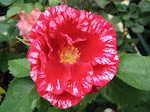You may think that the coming winter weather means an end to enjoying the blessings of the sultry season and all that the flower garden had to offer. But that would be wrong because even when we are months past the “realm of the rose”, the fall harvest includes this metaphor most popular for love, in a most curious culinary way.
It has often been said that great gardeners are usually great cooks - being a natural transition from veggie patch to the kitchen door. After all, this is where kitchen gardens got their name. But garden herbs and flowers have also long been pressed into service for medicinal purposes and sur la table.
I am what my grandmother used to call an “old fashioned girl”, a culinary throwback who spent many teen years, not collecting every Rolling Stones and Beatles album, but rather learning how to cook at the hip of the Galloping Gourmet after school. Later I graduated to the gospel of my “true” kitchen mother, Julia Child, who spiced up her presentations with frequent allusions to cookery methodology long past.
In short, cooking and then gardening became a passion fitting together like the proverbial hand and glove. About this time, my fascination with Victorian molds took hold. I scoured old book stores for bespoke recipes and antique shops for the elegant and functional molds, contraptions in shapes both classical and bizarre.
Finally I found a small volume entitled Victorian Ices & Ice Creams with 117 original recipes first printed in 1885 under the title The Book of Ices by that marvel of London ice queens Agnes B. Marshall. Discovered between this volume’s pages is an era when almost anything that was edible, fruit or vegetable, could be re-imagined as glorious sorbets, mousses, iced soufflés and ice creams.
 With today’s wide variety of ice cream machines, there is so little effort in these recipes that the drama is often left to the mold. Even a simple container can offer an impressive presentation when released onto an elegantly tiered cake plate or serving platter.
With today’s wide variety of ice cream machines, there is so little effort in these recipes that the drama is often left to the mold. Even a simple container can offer an impressive presentation when released onto an elegantly tiered cake plate or serving platter.So as you are planning your trip to Vancouver’s World Rose Festival, why not put this little tasty treat on your menu while rose leaves are still clinging to the vine (remember not to use leaves that have been sprayed with any pesticides).
Rose Water Ice
Take a half pound of fresh-gathered rose leaves; pour 1 pint of boiling water on them with 4 ounces of sugar and keep closely covered for about 5 minutes. Then strain off and colour the flavoured water with a little liquid carmine (natural colouring available at specialty stores). Freeze in a conventional ice cream maker according to manufacturer’s directions.
Ices are perfect as course palette cleansers at a special dinner party or great thirst quenchers on a hot day.
Recipe from Victorian Ices & Ice Creams
The Metropolitan Museum of Art
Charles Scribner’s Sons







No comments:
Post a Comment